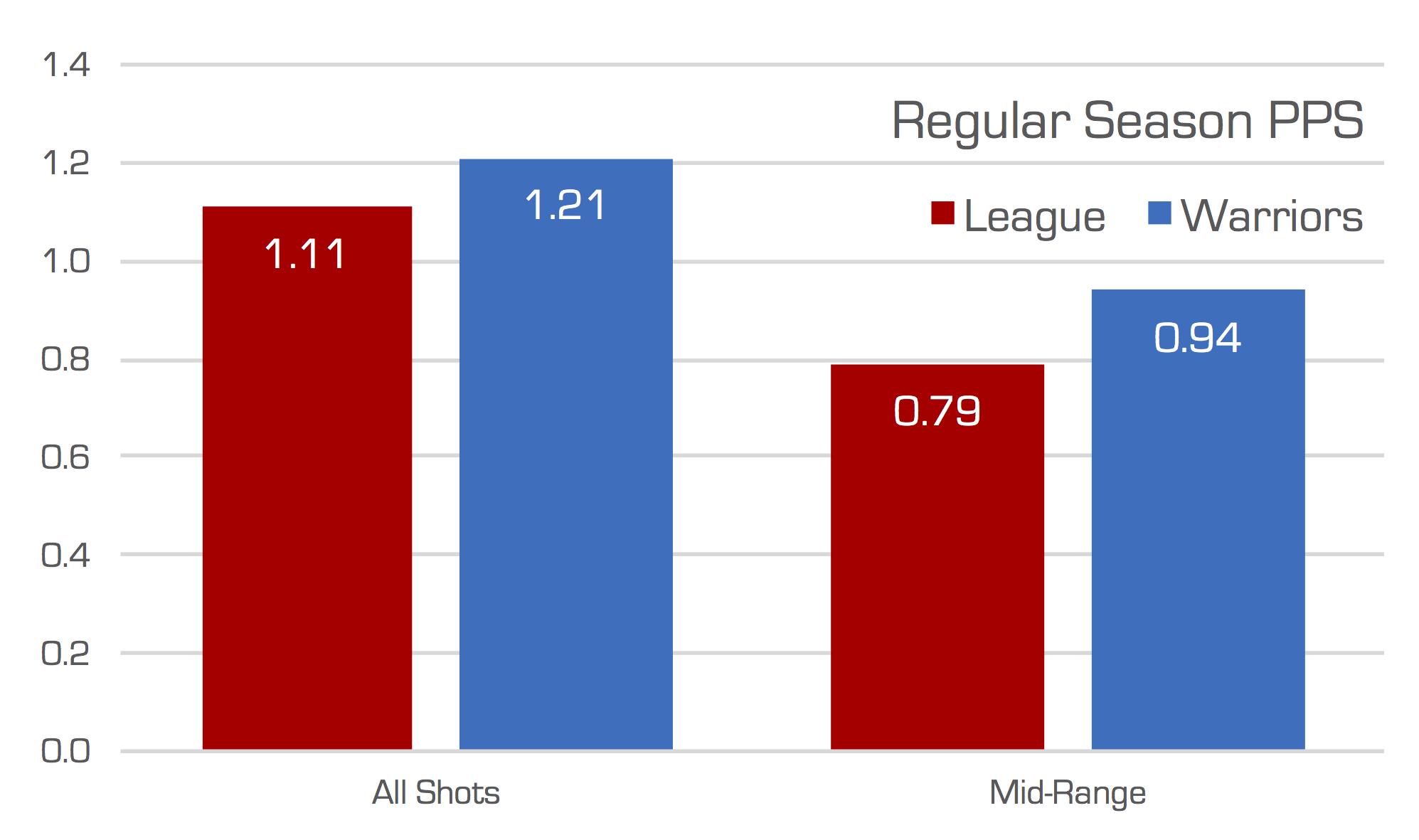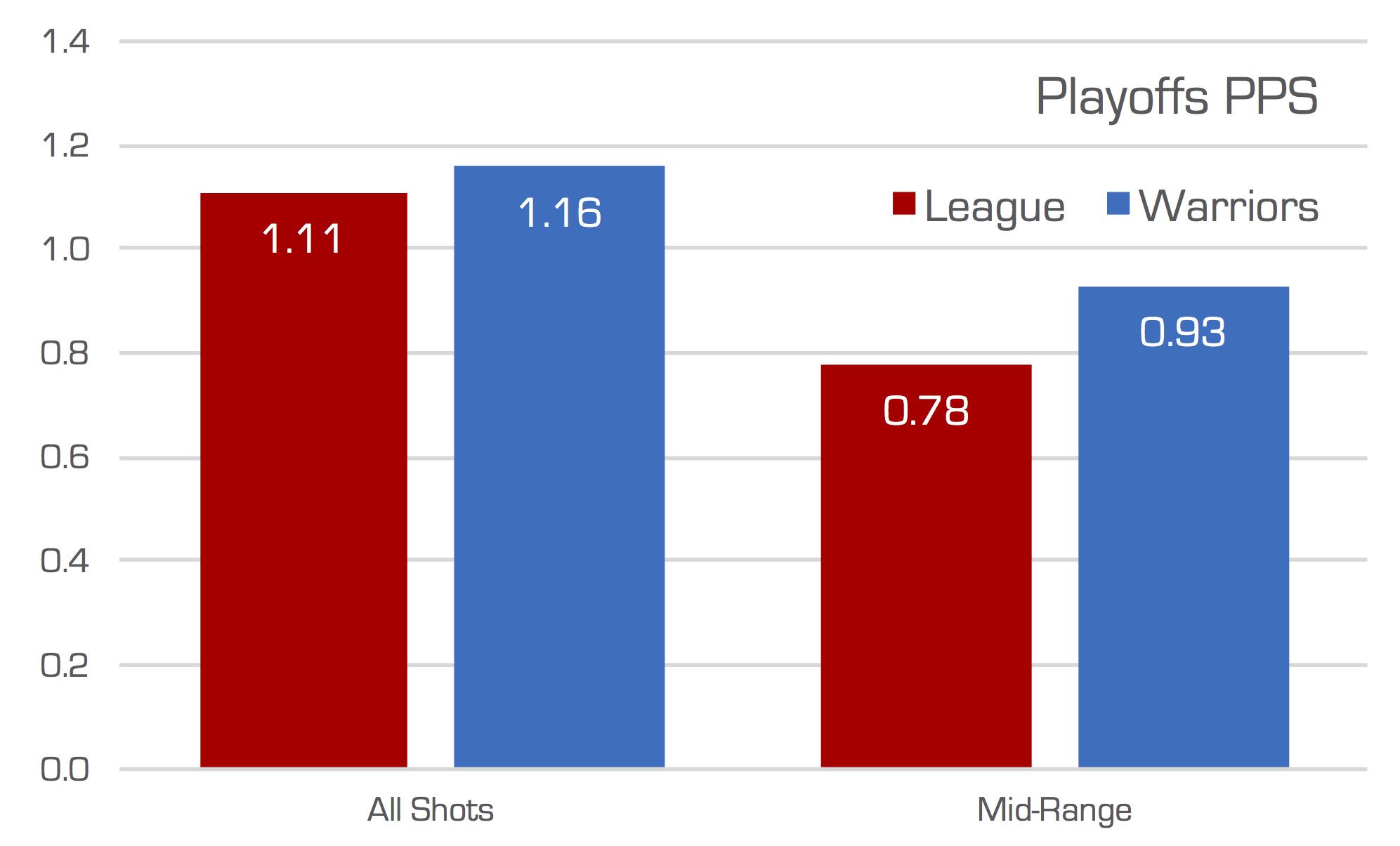Are the Warriors Making the Mid-Range Relevant Again?
![]()
In the 2017-18 regular season, team averaged 1.11 points per shot (where a trip to the line for 2 or 3 is considered a shot). Said another way, teams averaged 111 points for every 100 shots.
1.11 points per shot (PPS) is the league average and a good benchmark when assessing the value of a particular shot.
For years, analytics have suggested that teams should take less mid-range jumpers. In 2017-18, NBA teams averaged 0.79 points per mid-range attempt. Exchanging 100 mid-range jumpers for 100 average NBA shots would produce an additional 32 points.
NBA teams are learning from the numbers. Teams are taking less mid-range jumpers. Only 19% of a team’s FGA came from mid-range in 2017-18. That’s about half what it was 20 years ago.
Today, teams are averaging about 16 mid-range jumpers per game, but the Golden State Warriors, the NBA Champions and perhaps greatest team of all time, are averaging 20. Is their mid-range usage, which is counter to modern trends, a cause for their success, or are the Warriors so talented that they can succeed in spite of less-than-optimal shot selection?
As was said above, NBA teams average 1.11 points per shot (PPS). The Warriors far exceed that mark by averaging 1.21 PPS. On mid-range, the NBA averages 0.79 PPS, but the Warriors, a team stacked with incredible shooters, average 0.94 PPS.

Since the Warriors can be significantly more efficient than most of the NBA from mid-range, taking an excess number of mid-range jumpers isn’t as costly for them. If the Warriors could exchange five mid-range jumpers for five league-average shots (and leave everything else the same), they’d gain less than a point per game. That would help, but the Warriors so outperform most teams in other areas that it’s not essential for their success.
The margins were similar for the playoffs. There, the Warriors again averaged 20 mid-range jumpers per game. Swapping five mid-range attempts for five league-average attempts would give the Warriors about a point, but as we know, they didn’t need it.

At this point, we can’t conclude the Warriors’ dependence on mid-range is helping them, but we also don’t have evidence that’s it’s hurting them, at least not significantly. We must dig deeper.
The Warriors have several offensive superstars, but to succeed over an 82-game regular season, teams need contributions from their bench. No team is bringing a player like Steph Curry or Kevin Durant off the bench, and so, we can’t expect bench production to be as efficient as starter production.
Shaun Livingston, one of the Warriors’ primary contributors off the bench, is known as capable from mid-range but weak from behind the arc. If Livingston is finding ways to be reasonably efficient from mid-range while also bringing plus defense and passing, it could explain how the Warriors exceed the league average in mid-range usage while still posting overall elite numbers.
Livingston took 160 mid-range jumpers last season (2.3 per game), not a huge number, and he wasn’t that efficient with them. He averaged 0.88 PPS on mid-range attempts, the equivalent of a 29% 3-point shooter.
Livingston is a piece of the puzzle, but he doesn’t take enough mid-range jumpers to explain why the Warriors were significantly above the league average in mid-range usage. Livingston also isn’t efficient enough to suggest their dependence on his mid-range game off the bench is particularly savvy.
There are game situations when the analytics would suggest a mid-range attempt over a 3-point attempt, even if the mid-range produces less PPS. If a team is down 1 with 10 seconds to go, it doesn’t really matter if they get 2 or 3 points. What matters is if the shot goes in.
If a team is up 2 or 3 with 30 seconds to go, or many other situations down the stretch of a close game, the numbers would agree with taking a mid-range attempt. This is especially true for a team like the Warriors that can knock down mid-range jumpers at a high rate.
During clutch time (the last 5 minutes of games where the score is within 5 points), 13% of Golden State’s FGA were from mid-range. That was the 8th highest percentage in the league. So, the Warriors were leveraging their mid-range strength late in games.
But, many of Golden State’s games weren’t close. They had a total of 110 clutch minutes on the season where they took 180 FGA. This means that only 23 of their mid-range attempts on the season came from clutch time. These end-of-game scenarios aren’t the answer we’re looking for.
Are the Warriors finding a way to make the mid-range jumper relevant? They are, and the best explanation (as one might expect) comes with football and war analogies.
NFL teams gain more yards on passing plays than running plays. But this doesn’t mean that NFL teams should pass on every down. Part of the efficiency on passing plays comes from defenses respecting the offense’s ability and willingness to run. If the offense only passed, the defense would change personnel and formations and passing would become less efficient.
Basketball is different than sports like hockey, lacrosse and soccer in that players shoot over the defense and the angle of a shot doesn’t dramatically reduce the shot’s efficiency. This means that basketball players can be dangerous just about anywhere inside of 26 feet from the hoop.
In the same way attacks on multiple fronts will challenge a defending army, the more space an NBA defense has to cover, the more difficult it is to scheme. And much of the space in the halfcourt is mid-range.
For the defense to respect Golden State’s mid-range game, the Warriors need to be efficient from that area. On the average, they were significantly more efficient than the typical NBA team. But, a few players, in particular, have turned the mid-range into a devastating offensive weapon.
On the season, Curry took 130 mid-range jumpers and shot 60% on them. That’s good for 1.2 PPS. A Curry mid-range attempt is an elite NBA shot in terms of efficiency.
Durant led the Warriors in mid-range attempts in the playoffs. He took 162 of them or 7.7 per game (a huge chunk of their overall mid-range attempts). On those attempts, he generated 1.09 PPS. It’s still below the average NBA playoff shot. However, when the defense is set and the Warriors need a bucket, Durant’s ability to get a shot with that efficiency is a serious weapon.
The Warriors as a team, and a couple players in particular, have found a way to be efficient enough or even excellent from mid-range. As a result, opponents must plan to defend that area on the court. This hampers the defense’s ability to defend the hoop and 3-point line.
The Warriors have made the mid-range jumper a relevant component of their balanced offensive attack.
